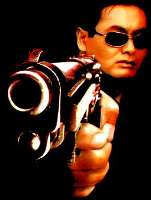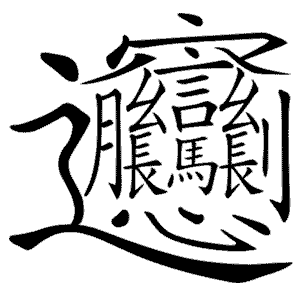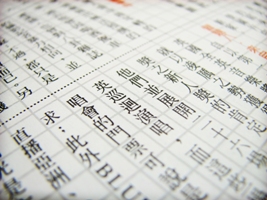Learn Mandarin Chinese
Progressive self study course for absolute beginners to intermediate learners

Progressive self study course for absolute beginners to intermediate learners

There are over 400 lessons to choose from. Absolute beginners should start at lesson 1. Each lesson continues where the last one left off.

Later lessons use the Chinese that was taught in earlier lessons. This way you are constantly reusing and remembering what was taught.

Premium subscribers get access to exercises, games and flashcard activities to reinforce what was taught.

Sign up with your Facebook account to try out the first 4 lessons of the course for free.

Today is August 19, 2007 which also happens to be the 7th day of the 7th month of the Chinese lunar calendar. This day is dedicated to love and is the Chinese equivalent to Valentine's day.
The legend behind this day dates back more than 2000 years and has been recounted by poets and in Chinese operas for generations since then. It resembles those found in Greek mythology, as it also goes on to explain some of the natural phenomena we encounter in our world.
The story begins with the seven fairy daughters of the Emperor of Heaven coming down to earth to bathe in a river one evening. An orphaned cowherd came across them and was memorized by the beauty of the youngest daughter, so he proceeded to steal her clothes that were lying on the riverside. The fairies finished their bath and flew back to heaven, leaving behind their youngest sister who had no clothes. The cowherd asked her to stay on earth and marry him, which she agreed to do.
They lived a happy life for several years, before the Queen demanded the return of her daughter back to Heaven. The cowherd chased after her into the sky. On seeing him, the Queen used a hairpin to create a line in the sky, separating the two. That line turned into the Milky Way. From then on, the two lived on different stars - Altair and Vega. Taking pity on them, the Queen allowed them to visit each other once a year, on the seventh day of the seventh moon.
Legend has it that on this day, magpies fly into the sky to create a bridge for the two to meet. Five color ropes are made by girls wanting to celebrate this occasion, and thrown on rooftops for the magpies to use. Additionally star gazing and praying for love and marriage at local temples is also popular on this day.
The traditions for this day contrast with those of Valentine's Day (which is also celebrated as a Western custom in larger cities), which involve more gift giving between lovers.

So you have made the decision to learn Chinese. Excellent! Now what? What's the best method to learn Chinese? Obviously if you could just pack up your things and move to China, that might be a good start, but even that alone isn't enough (as I found out the hard way). So what should you do when you get there? Or what can you do to prepare first? Well, fortunately you have lots of choices (which may or may not be a good thing). Should you join a class? Find a one on one teacher? Look for a language exchange partner? Invest in books, CDs or other self study courses?
Well the truth is, no single method is good enough on its own (which is why this post is titled "best strategy" and not "best method"). You could invest in the Pimsleur series and master it completely. But even that will only get you familiar with a limited aspect of the language. A classroom approach might be great for some. However you may be shocked to find the outside world not following the rules and structure taught in class. So maybe "learning by doing" is the answer. Forget about formal training and learn by making mistakes - get out there and learn what people are saying in the real world! Unfortunately that too doesn't work for most personalities, plus this approach lacks the structure and system required to explain what it is the people out there are saying.
The solution then is a combination of all of the above. For my first few years in Taiwan and up till now, all my Chinese was self taught using a combination of self study courses and books out there. I was able to pick and choose the areas I wanted to focus on, in a manner that worked best for me and my personality. In the last month, I have enrolled in a university course, which is my first formal study of Chinese. This has opened my eyes to new methods of learning that I wasn't exposed to previously. While my listening and speaking skills are good for my level, my reading and writing skills are much lower than my classmates. This indicates to me that while this particular course I'm in is great at teaching reading and writing, it can improve in teaching listening and speaking.
You will see some of the ideas and concepts I have been experiencing added to the CLO course over the next little while. The idea is to provide a smorgasbord of learning methods, allowing listeners to choose which methods work best for them, and which areas they want to focus on. Don't feel compelled to have to use every new feature and tool being introduced. Imagine you are walking through the street scene pictured above. You don't need to go to visit every shop to find what you need. However, if enough resources are made available, there should be something for everyone, and you should be able to tailor make a strategy that meets your particular needs. It's been very rewarding for me to get to know you listeners as individuals, and what your own personal goals and strategies for learning Chinese are, and what techniques I can implement to help you out. The CLO course looks very different today than what I envisioned a year ago when I first started. With your help, I expect it to look a lot different a year from now, so keep the feedback coming!

During my first year in Taiwan, with my Chinese skills at a bare minimum, I found it frustrating to constantly be in situations where I couldn't understand what people were saying around me, or to me. That's when I learned a neat trick to get myself more involved - guessing! I began to recognize patterns in what I was hearing around me, and began to build around that.
I first learned how to recognize subjects - "I", "you", "he / she" etc. I then learned how to recognize questions - "....ma?" along with the key question words "what", "which", "where", "who" etc. After that, it just became a game of fill in the blanks. I might be in an elevator when someone asks "you... where...?" I would instantly reply "Jiānádà" (Canada). The gleam on their face told me that I had answered their question of where I was from correctly!
Later, as my vocabulary began to increase, I began to recognize key verbs. I would walk into a McDonalds and point at what I wanted to order. The cashier would then ask me a question (you want...?) . In the early stages, this was a pure guessing game. I would quickly rack my brain trying to think what questions I would get asked when ordering fast food in Canada. "What do you want to drink?" - Got it! I would then point at the drink I wanted (this time it was me who had the gleam, as she poured the drink I wanted). Next question just before payment - "you want... or...?" I was already waiting for her to ask if I was planning to dine in or take out, so I quickly pointed at the ground to indicate wanting to dine in. This was a great confidence booster for me to be able to function this way. Well, until I ran into a cashier one day who asked "you want..." followed by some new words I hadn't heard before. My confident demeanor vanished in an instance. Was this a new way of asking if I wanted to eat in? I tried pointing at the ground, but could tell by her confused look that I wasn't even close. (It turns out that she had the nerve to ask me if I wanted to upsize my fries and drink!)
I realized then that I had to increase my vocabulary to increase my guessing odds. But how could I forecast what questions and what new vocabulary someone was going to throw at me next time? I decided to play the odds again. Over time, I began to pick out words that I would hear repeated in these different questions. I figured that if I heard a word being used repeatedly, that meant there was a greater chance it would be used again in the future, so it was in my interest to find out what it meant. After finding out that "hē" meant "to drink," I was a lot more confident answering "you want drink what?" than answering "you want... what?"
This is the same concept used in the CLO course. Certain words get introduced in lessons and are never brought up again, so you are probably less likely to remember them. Other words get introduced, and then are later brought up again in future lessons. Learning the more frequently used words first allows you to set the context to "guess" the meaning of the remaining words. You may notice this approach in the explanation portion of the lessons too. We first listen to a conversation without translating, then pick out the words we do know to help us figure out what's remaining. Developing this technique can be valuable in improving your listening skills.

The two most popular sports in Taiwan are basketball and baseball. Every time a school bell rings signaling the start of lunch hour or end of classes, you will see a rush of kids to the basketball court to get in some practice time. Sales of basketball clothing and shoes modeled after top NBA players are hot sellers here. Baseball is also quite established with the local Chinese Professional Baseball League (CPBL), featuring six teams, the winner of which goes on to play in the Asia Series competing against teams from Japan, South Korea and China.
One major difference between many Asian sporting leagues and their Western counterparts, is that in the former, teams are owned and named after corporations, rather than cities. While each team does have a regional market, home teams aren't always played there. The current 6 teams in the CPBL are the Elephants, Whales, Bears, Cobras, Bulls and Lions. While interest in this league has had its highs and lows (due to a few game fixing scandals that emerged), interest in baseball as a whole has been reignited in the past few years, when the New York Yankees baseball team signed Taiwanese pitcher Chien Ming Wang to be one of their starters.
Since then, Wang hasn't looked back, turning into one of the premier pitchers in the game. This has caused a huge fan base to develop in Taiwan, not only in Wang, but in the Yankees organization as a whole. Yankees games are televised live and repeated at other times of the day with Chinese commentating. How the Yankees fared in their last match is included as part of the sports wrap up in local news. When Wang is pitching, it isn't uncommon to see the game on multiple channels as well as televised on big screens in public settings (for games that take place early morning Taiwan time). Wang's achievements usually make the headlines in all newspapers, recording how he fared in the previous day's game. Indeed, Wang has become an ambassador for the sport in Taiwan, and his trips back to the island draw a media circus. His image is used in advertising all over the place, selling everything from McDonald's hamburgers to HP printers.
It can be expected that this kind of excitement shown towards trend setting athletes such as Wang in Taiwan, and Yao Ming in China will prompt scores of new kids to want to follow in the footsteps of their idols. I can't imagine what the atmosphere here will be like years from now when there are multiple teams with multiple Asian stars leading them!

There are different approaches to learning Chinese. Some choose to only focus on listening and speaking. Others add reading to the mix. The truly adventurous however attempt to add being able to write in Chinese to their portfolio. On the surface, this looks like an impossible task. The Chinese language has thousands of characters - a lot of them quite complicated looking. How on earth is anyone expected to memorize them? Today's post will detail one of the secrets behind why the process isn't as difficult as it seems on the outside!
A person with no English background may look at the written English language and think "how can anyone memorize how to write so many words?" A closer look however will reveal that it's not the words you are memorizing, but the letters they are composed of. Once you have the letters down pat, all you are doing is rearranging existing letters in new combinations to form new words. Well, unbeknownst to many, Chinese characters work in a similar fashion! If you were to actually study characters in detail, you will notice that many share common features, known as radicals. Once you learn how to write the common radicals, you will find new characters are just different combinations or variations of existing radicals. Since many of the characters tend to be pictorial representations of certain concepts, you can even try to learn why certain radicals are combined and what the meaning is behind the combination. Take a look at the following example.
女, 子
The first character represents a woman (it somewhat represents a person sitting down cross legged). The character next to it represents a child. Put these two together and you get:
好
which is the character meaning "good." The pictorial representations and meanings can be quite abstract as you can see, but it does add to the enjoyment and ease of learning the language if you are able to think in these forms. Now once you have learned how to write the radical for woman, you will notice it cropping up in lots of other characters.
媽, 按,要, 妞,妹,如,妥,姓,婪,姚,姆
Notice how the same radical shows up on the side (a squeezed version) in some characters and at the bottom in others. This particular radical takes three strokes to write, so once you have mastered it, that is three less strokes for you to memorize each time you write one of these new characters using it. In total, there are 214 radicals, although some are a lot more commonly used than others. If you have ever wondered how Chinese dictionaries are used - here's your answer. The thousands of characters out there are neatly sorted into dictionaries by radicals, so there's another good reason to learn them. In future posts, I will go over which radicals and characters you should start learning first and how to go about actually "learning" them.

Today's post describes the naming system used in Chinese families and how they differ from Western conventions. The biggest difference is that in Chinese, the family name is listed first. This can cause a problem when moving to Western societies. Some adopt the Western convention by using a Western first name and moving their family name to the end (such as actor Jackie Chan). Others may choose to retain their Chinese name but change the word order (such as Chien Ming Wang, pitcher for the NY Yankees baseball team). Others may decide to leave their name and word order as it is, such as in the case of Chow Yun Fat (pictured above), the famous Hong Kong actor. For less common names, this can cause confusion as to which is the first name and which is the last name. Indeed, Chow Yun Fat has corrected many who address him as Mr Fat, pointing out to them that it should be Mr Chow instead.
Unlike in Western societies, where there are several common first names and a lot of varying last names, in Chinese there are a lot of common last names, and it is the first name that tends to vary from person to person. In fact, estimates suggest that the top 100 common family names are shared by 90% of the Chinese population! Chinese family names are usually formed using a single character, whereas the first name is made up two characters. As a teacher, I found it fascinating to look through the class attendance lists which were all uniform as every student's name was 3 characters long. You may also notice this the next time you stay to watch the credits at the end of a Chinese movie.
Whereas in English, there are certain words reserved as common names (John, Peter, Paul etc.), in Chinese, pretty much any word combination can be used to form a given name. This sometimes causes a problem when Chinese people are looking for Western names, as they assume the reverse is true. This results in their trying to form English names for themselves using words out of a dictionary, or by forming a literal translation of their Chinese names which can produce strange results (the first producer I used in Taiwan for my podcast introduced himself as "Dull Bird" which I didn't bother questioning). When a child is born, convention is usually to give them a nickname to begin with, giving the parents time to seek a more proper name for the child (usually done within the first month of birth, sometimes with the help of a fortune teller). This is why stories using children often refer to them as "Little so and so" or using a character that is repeated twice (makes it sound cuter!). It is usually possible to guess the gender of a person from a name, since men tend to be given names with masculine meanings while women's names usually promote female qualities. When women get married, unlike in traditional Western culture, they often retain their maiden name. Children however will adopt their father's family name.
There are several options available for Westerners looking to create Chinese names for themselves. One option involves a standard transliteration of their Western name into Chinese. This is the format used for many famous Western stars giving us names like Tāngmǔ Kèlǔsī (汤姆克鲁斯) for actor Tom Cruise. However, this result doesn't follow the normal pattern of 3 characters, so it is obviously referring to a "foreigner." The other option is to consult the help of a Chinese person to come up with a name that combines elements of your first and last name plus any meaning you may want to convey (similar to how brand names get translated into Chinese as in our last post).

One thing that struck me during my initial stay in Taiwan, was how everything imported from western culture had to be imported into Chinese first. If I asked someone on the street where the nearest McDonalds was, they wouldn't know what I was referring to, even if there was one across the street, since I would need to use the Chinese equivalent 麥當勞 (Màidāngláo). The same is also true for famous Hollywood actors, books or movies. Ask any kid who Harry Potter is, and they couldn't tell you. But refer to him as 哈利波特 (Hālì Bōtè) and of course they would rave about the latest book!
As you can see from the above examples, the Chinese equivalent is usually formed using a transliteration of the sound using the closest equivalent in Chinese characters. While it's usually possible for Westerners to deduce the English equivalent by hearing the Chinese (especially if you have heard it before), local Chinese speakers usually have a harder time going the other way. I found this to be an interesting phenomenon, since characters that to us are homonyms (mài and mǎi for example) are completely distinct to native Mandarin speakers so it is harder for them to associate them together.
It is more complicated than this though, as some transliterations may end up producing meanings that don't evoke the proper emotion. Some companies have a done a great job of combining the transliteration with a reasonable meaning. One of my favorites is KFC, which becomes 肯德基 (Kěndéjī). That sounds reasonable close to "Kentucky" while retaining the jī at the end meaning "chicken." Another one I found particularly interesting was Coca Cola which is 可口可樂 (Kěkǒu kělè). From a transliteration point of view, it would have made much more sense for them to invert the characters to produce "Kǒu kě kǒu le" or something similar. However, the former name has a literal meaning of "tasty cola" which is obviously a good feeling for Coke to evoke and is why it was chosen.
So what is the lesson to be learned here? When in Rome, do like the Romans do. Learn what the Chinese equivalent of your name is. (In my case Adam becomes 亞當 (Yǎdāng)). Learn the name of your country and city is in Chinese if you expect to be able to tell where you're from. If there are any other topics you wish to talk about, find out what their equivalent is in Chinese first to give yourself a head start.

My first lesson in Chinese characters came early on - during my first day at the high school I would be working at, soon after I had come to Taiwan. All of the teachers had to be present for a morning meeting led by the principal. Like anyone on their first day on the job, I showed up on time ready to begin my new experience. However, I soon found that since the meeting was conducted entirely in Chinese, I had to find a way to occupy the next few hours. I noticed that there was a pen and paper placed in front of each person to take notes. I also noticed a card placed in front of each person with Chinese writing on it. I asked the person next to me what was written on it, and he explained that it was my name written in Chinese - "亞當老師" (Adam Teacher). I decided that this was the perfect opportunity to learn how to write my name in Chinese (after all, I had a few hours to kill with lots of paper in front of me to practice on). So that's exactly what I did. By the time the meeting was over, I was pretty proud of myself as I seemed to do a reasonable job of copying my name exactly as it read on my name card.
The next day in class, I decided to impress my students by showing them that I knew how to write my name in Chinese. As soon as I had placed the chalk on the board and began my first stroke, I heard a few "wrong!" choruses from the students. "How could this be wrong if I haven't even finished?" I retorted. That's when I learned my first lesson in writing characters. Since Chinese characters were initially written with paint brushes back in the day, the order of strokes used to write the character made a big difference to what the end character looked like. Nowadays, even when using pens and pencils to write characters, it is still possible for the trained eye to tell when a character is not written properly because of the wrong order of strokes used to write it.
There are rules for stroke order. In general, top always comes before bottom, and left always comes before right. So horizontal strokes are written from left to right and vertical strokes are written from top to bottom. Where there are multiple elements like in the example picture above, there are rules for which components are written first.
Rather than memorizing these rules, I found myself a dictionary that listed the stroke order for each character. I followed this order to practice the most commonly used characters. Do this enough times and you'll eventually find yourself automatically figuring out the stroke order for new characters just by looking at them.
Future posts will detail how I went about figuring out which characters to learn first.

This is a question that many students ask when learning Chinese. When is the best time to begin learning how to read and write characters? Should I focus just on speaking? Should I learn to read without writing? Is it even possible to begin learning how to read and write before learning how to speak?
At first glance, Chinese characters can present quite a mystery to foreigners. There is certainly an awe to them. How on earth are we expected to learn how to read several thousand characters, leave alone learn how to write them? Well, in this blog, I hope over time to reveal some of the secrets behind the process of learning how to read and write characters. Just make sure you don't go around telling all your friends how it works. It's a lot like learning magic - if you start telling everyone how you do it, that takes away a lot of the fun, right? Why make it less impressive that you can read and write Chinese? Learn the secrets, enjoy the process, then wow all your friends!
I'll use today's post to answer one of the questions above. Is it ever too early to learn to read and write characters and is it possible to learn them even before you can speak? The answer here is no, it's never too early to learn. In the current university class I'm in, there are several foreigners with a remarkable ability to read and write but who lack experience in their listening and speaking skills. The process to learn to read and write can be taught separately from the listening and speaking process, and with time, anyone can learn how to do so in a reasonable amount of time. Having said that, having a command of Chinese characters can aid greatly in vocabulary building, especially if you are living in a Chinese community, since you now have the ability to acquire knowledge from reading the vast number of signs around you, and being able to read books and stories at your level, that will aid in recognizing grammar and sentence patterns.
In future posts, I will provide more of a background on Chinese characters and how to demystify them, while outlining some of the steps needed to learn how to read and write in Chinese, along with techniques that can greatly reduce the amount of workload required so stay tuned!

In recent while, I've gotten a few emails regarding the best way to study Chinese characters. While I'm sure the answers to this question will vary from person to person, I thought I would use this blog to detail my own personal experiences with learning how to read and write Chinese.
One of the reasons that many find it hard to learn Chinese, even while living in a Chinese community, is due to not being able to read Chinese characters. Most learners of second languages get the majority of their learning from reading. If you're trying to learn English while living in an English speaking country, you will get a lot of peripheral learning from being able to read. While out on the street, you may see a bank and recognize it as being so, along with the word "bank" printed on the sign outside. However, looking at a street scene like the one pictured above, it's hard to get any learning when you don't understand any of the characters printed.
The majority of my initial learning of characters came from waiting at traffic lights on my scooter. I would look at street signs that were printed with the Pinyin equivalents below and try to match the characters with their equivalent Pinyin. I would pick out characters that were distinct and easy to remember such as 大 and 小 or that I were likely to see such as the characters for road or street and would pick them out from address signs. I learned numbers and tried to pick them out where I could too. I then tried to extend this into something practical by learning the characters for certain foods. I felt much safer looking at a menu and being able to pick out beef (牛肉) at a glance instead of always having to rely on others. My favorite fruit was mango, so I could soon instantly look at the fruits and beverages section and pick out anything with 芒果 in it.
In future posts, I will further detail my experiences in reading and writing. If you have any tips that have helped you, please do share!